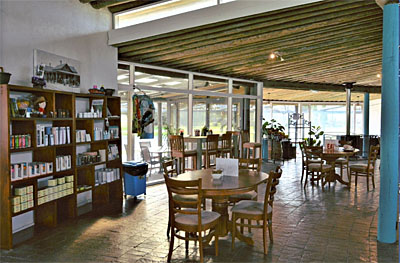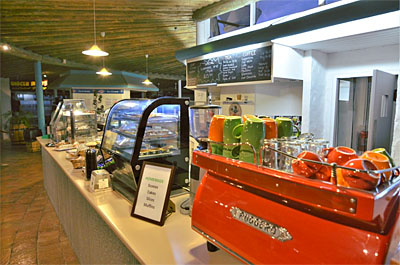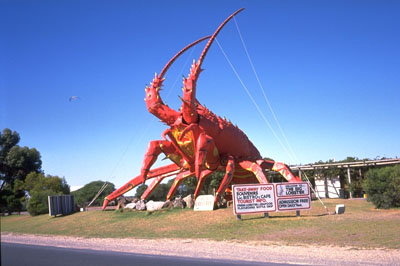Known locally as "Larry", the Big Lobster dominates the northern entry to Kingston SE (South East) (there is also a 'Kingston on Murray' near
Cobdogla in the Riverland of SA)
Opened in 1979 to reflect the crayfishing region of the south east coast, it featured souvenirs, an information centre, fresh lobsters and
a varied food area making sandwiches, salads and rolls, with a restaurant of a night, and soon became a popular spot along the Princes Hwy.
Commissioned and originally operated by Paul Kelly, the 18 metre high fibreglass and steel sculpture weighed 4 tonnes and was located beside
the Big Lobster Motel at the junction of the Princes Hwy (1) and the Alternative route to Millicent and then Mt Gambier around the coast through
Robe and Beachport. It was one of the first major Big Things in Australia following the Big Banana at Coffs Harbour and the Big
Pineapple at Nambour. There were only a few big things along the highways 40 years ago.
It closed for a while around the 1980s and fell into disrepair. There have been several attempts to rejuvenate it over the years with the most recent
being in 2019 and it is now restored to its former glory and 'Janet's Takeaway' operates inside.
Besides snacks and meals, there are paintings and local souvenirs available with craft work from local artists.
If you are stopping to take a photo, do me a favour and at least pop your head inside for a look around and a coffee.
I want it to last this time as it is a major attraction along the road and a pleasant stop after the long drive north through the Coorong.

The Big Lobster at Kingston SE. as it looked soon after its opening in 1979
|
The Lobster is on display 24 hours. 7 days and is located on the highway.
The complex is open from
9.00am to 4.00pm Sunday to Thursday (School Holidays)
9.00am to 3.00pm Sunday to Thursday and
9.00am to 7.00pm Friday and Saturday.
For enquiries contact Janet on 08 8767 2019.
Maria Park is an interesting park opposite the lobster where a memorial erected by the National Trust in 1966 commemorates the 26 men,
women and children who survived the Maria' which was wrecked nearby on a passage between Port Adelaide and Hobart.
Maria was a 136 ton, wooden brigantine, built in Dublin, Ireland, and launched in 1823 as a passenger ship.
On 28 June 1840, it foundered on the Margaret
Brock Reef near Cape Jaffa, south-west of the current site of the town of Kingston SE.
in 1834. The survivors, men. women and children were subsequently massacred by local aboriginals as they attempted to return overland to
Port Adelaide or Encounter Bay, some 160 kilometres north.
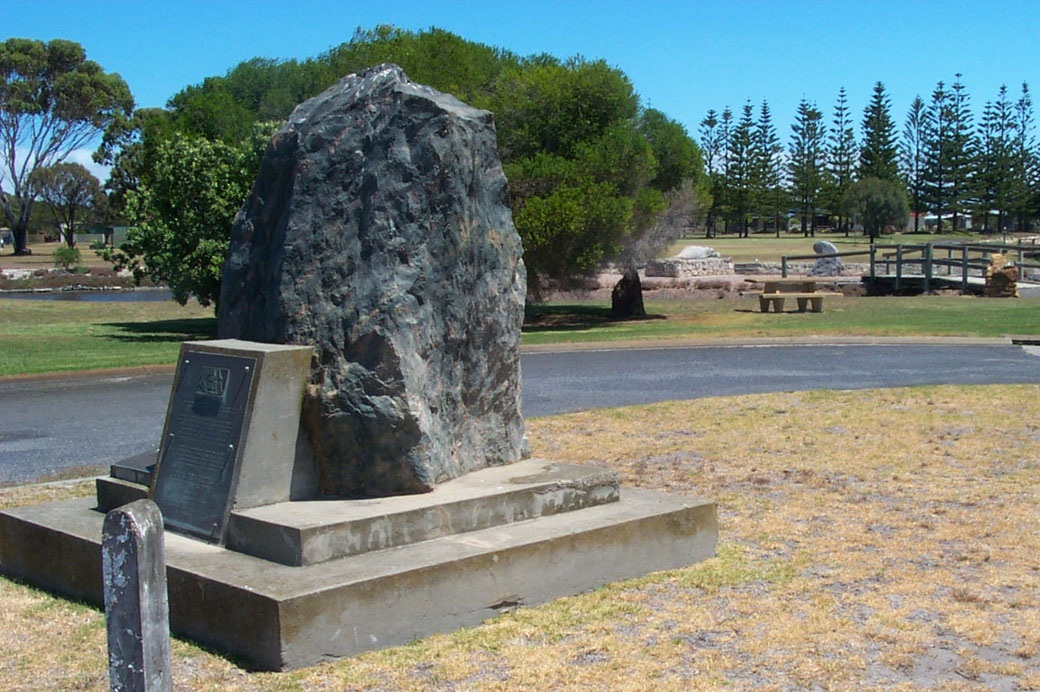
The Maria Shipwreck monument in Maria Park opposite the Big Lobster.
The "Maria"memorial commemorates the ill-fated passengers and crew of the 'Maria', wrecked
off Cape Jaffa in 1840. It is a 2 metre high blue-grey Karataphyre quartz rock, weighing around
five tons and quarried from natural outcrops on the Keilira property of the late Mr. Peter Vandepeer.
The Maria Creek and park also take their name from the incident.
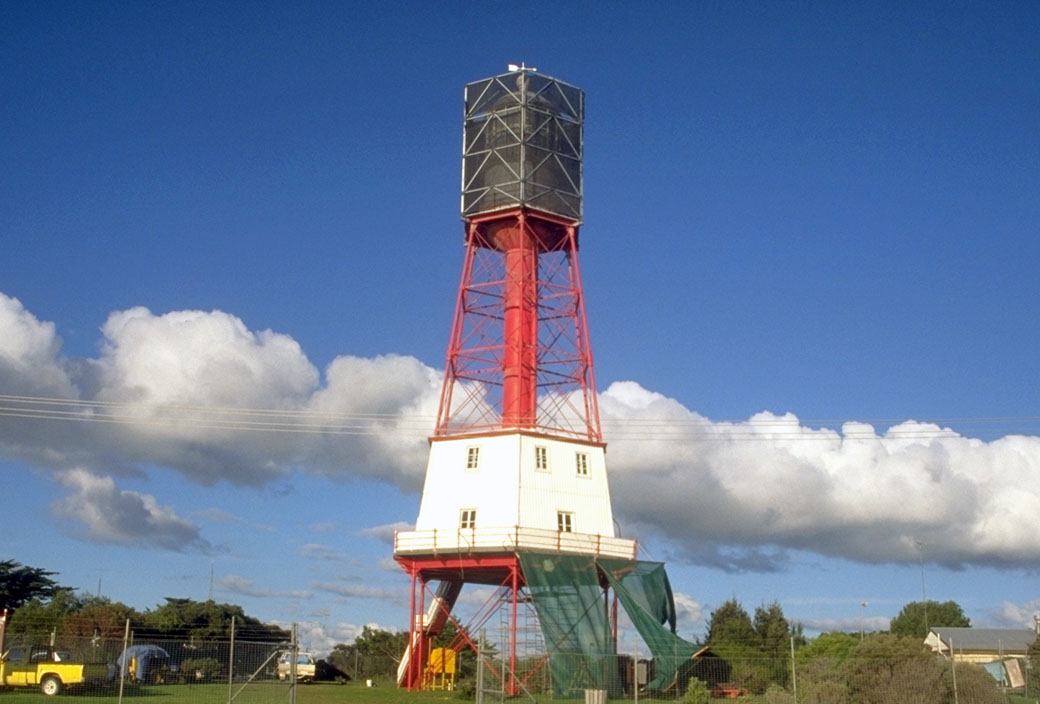
The Cape Jaffa Light, now moved into the town of Kingston.
After the wreck the crew and passengers made it to the shore of Lacepede Bay where they met up with local aboriginals of
the Milmendjuri clan of the Tanganekald tribe who agreed to lead them to Port Adelaide. The story from here is a bit confused.
Counter claims that the aboriginals coveted the clothes the survivors were wearing, and that the sailors began trying
to take advantage of the local Aboriginal women led to hostilities. Whatever the reason, the result was that 25 of
the 26 survivors were killed. One young girl survived and was looked after by the Ngarranjeri people until eventually handed over to Europeans.
The most likely story is: The Sailors and passengers promised blankets and other goods for safe passage back to Encounter Bay,
they also promised to return with the goods. The Aboriginal mob was unhappy with this arrangement and wanted something now that they
could use. The sailing party refused, and a fight broke out, of which the white men lost.
When news of the massacre reached Adelaide, Governor Gawler directed that not more than three members of the guilty tribe, were to be
brought to `summary justice `and executed in front of the tribe. Two were hanged at the site where the European`s bodies were found.
The passengers and crew consisted of the following 25 people whose names adorn the plaque on the monument:
Captain William Smith and his Wife.
Samuel Denham and Mrs Denham and their five children (Thomas, Andrew, Walter, Fanny and Anna).
Mrs York (sister of Mr. Denham), who had recently been widowed and her infant.
James Strutt who had been hired as Mrs Denham's servant.
George Young Green and Mrs Green.
Thomas Daniel and Mrs Daniel.
Mr. Murray
The ship's mate and crew:
John Tegg
John Griffiths
John Deggan
James Biggins
John Cowley
Thomas Rea,
George Leigh
James Parsons.
|

